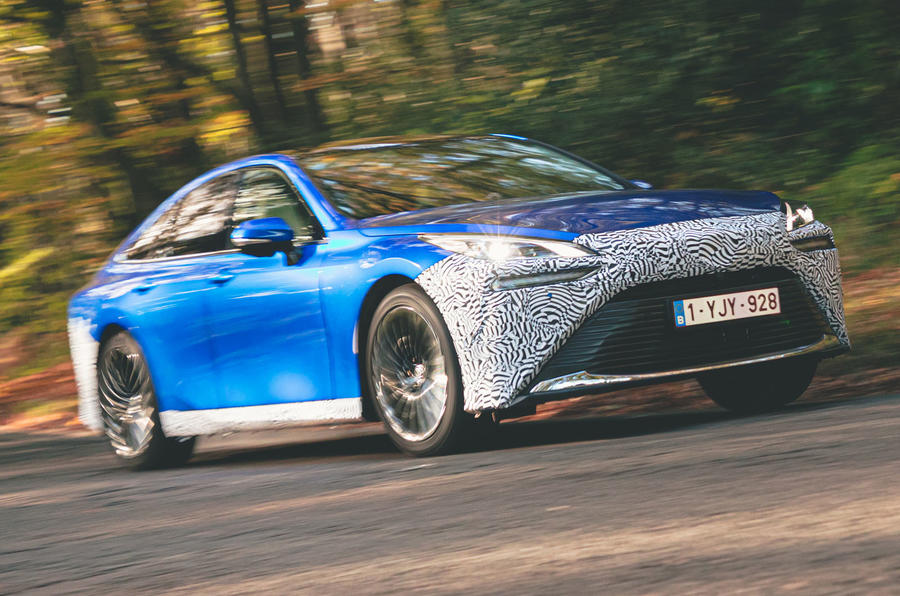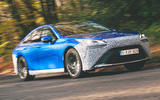What is it?
When Toyota talks about the Mirai, it frequently references larger vehicles: trucks, trains and more. The Mirai may be a hydrogen fuel cell car, but it’s only part of Toyota’s ambition.
This is the second Mirai but Toyota’s ninth FCEV. It started work on them in 1992, and it wasn’t until its fifth that it homologated one.
The first Toyota Mirai, introduced in 2015, sold modestly. Around 11,000 found owners, some 180 of them in the UK and 829 across Europe. Toyota aims to increase that tenfold this time, so still small volumes for a company of its size, but it makes clear that it’s working towards something else.
The smaller the vehicle and the shorter its intended range, the more appropriate battery-electric tech seems. So for a scooter you would look to nothing else; on a ship the size of a small county, not so much.
Cars and vans are, depending on their size and what you’re going to do with them, where I think Toyota imagines the crossover. No, not that sort of crossover. If you’re going to drive long distances, pull big loads or operate in poor conditions, perhaps you will want a hydrogen fuel cell, so you can refuel quickly and not have to carry heavy batteries. If Toyota is right (and China’s investment in the tech suggests it’s in influential company), the infrastructure could grow enough that what has been seen as ‘the fuel of the future’ might lose the joke ending ‘and always will be’.
We will see. For now, to this Mirai. It’s big, based on the platform that underpins the Lexus LS. It’s all but five metres long, which is handy, because while the fuel cell stack is much smaller than before, the system still takes up a lot of room. Sitting under the bonnet, the stack has 330 power cells, rather than the 370 of its predecessor, yet makes 172bhp (up from 153bhp) and weighs 50% less.
The new Mirai is rear-wheel drive, and between the bonnet and the rear wheels there are three hydrogen tanks rather than a drivetrain: one in the central tunnel, one under the back seats and one in front of the boot. Between them, they hold 5.6kg of hydrogen.
There’s still also a 1.24kWh buffer battery weighing 45kg, mind, which absorbs regenerative energy or gives a boost to the 180bhp motor if it asks for more than the stack can deliver.
































Join the debate
Add your comment
I shall confirm the 400 miles range and pleasant driving by real-world use. If both true, a 4-years Business Lease makes sense as am near an H2 supply, dependent on interest rate and forecast depreciation, for our 10k annual useage; we'd buy the car after the 4 years if time-proven. Five seats are more than we need. If the price IS £50k then it considerably undercuts the equivalents, the TSL S, the E-Tron and the Taycan.
I dislike the current aggressive Lexus spindle grille, much preferring the un-camouflaged YouTube video of the '21 Mirai - so using a Lexus LS chassis with a more discreet envelope is the correct design decision by Mr Toyoda. As for the lightning-quick acceleration of these 3 comparison BEVs, my 0-60 5.9secs 2007 GS450h saloon is more than enough in today's driving conditions.
I rented an 85 Model S for 300 miles 5 years ago to verify the Motoring Press - it did not provide the confidence of a luxury £90k purchase. Its Autopilot constraints are well known, the 2/3rds depreciation after 5 years too high, the removal of free Supercharging self-inflicted damage.
What a load of BS .
How can you confirm the 400miles range if the mirai 2021 are not sold yet and only given to journalist in the guise of the XLS trim that as a projected WLTP range of 357miles ?
Sure the price it's not high as it's still heavily subsidized as the previous gen but the projected residuals if we are looking at the previous gen are horrible one of the worst performer in the world , even in California where they have around 40 H2 pumps , the few Mirai leased over there as soon as the leases expire , most of them collects dust at the toyota dealer at a prices between 7.000 to 17.000 $ , and that with a 15.000$ fuel card included ! there are many unhappy customer complaining about refueling problems, low range, programmed venting of hydrogen (loses about 30miles per week) etc.
And funny that you think this car would have better residuals than a model S where Tesla has one of the best value retention on the market (no seriously google it) . This car is 5+ meters and barely seat 5 people (as per other reviews ) and the boot is vw golf sized.
How can you confirm 400 miles on a car that is not even made yet, besides that it will still cost more than 5 times the amount in fuel as a Model 3, this new mirai wont drop over 10k over the old one, your GS450h isnt a hydrogen car so why add it to the mix, teslas depreciation is excellent and im not even sure a model S was 90k 5 years ago
"Although I imagine you would still want to live or work near one of the UK’s dozen or so hydrogen filling stations."
There are lots of reasons that I can think of as to why this car's predecessor didn't sell in great numbers: it was spectacularly ugly and very expensive, but that there ^ is probably the main one. I looked up these filling stations and the nearest one to me is near (or at) the Honda factory in Swindon, over an hour's drive away!
In my opinion the best supportive point for Hydrogen, is probably that -- it seems the best bet in terms of how to transform world's shipping into zero emissions; the connection being assuming hydrogen is being produced in enormous scale in future in great number of off shore and near shore wind-mill centers -- there will be huge incentives among coastal countries where shipping is important to utilize Hydrogen anyhow produced in enormous quantities within their economies for other uses than just for shipping.--Yes I've heard Elon Musk's strong emphasis and what terms he employs. Even so, I think there shall be huge Hydrogen economy, because zero emission isn't just about cars after all -- it's also about ships and airplanes. --And Hydrogen also looks as the best bet to power, future jet-airliners. With Hydrogen economy already present, there shall be enormous incentive to use it more widely; hence I'm actually not yet convinced despite strong opinions -- that the Battery-Electric-Vehicles shall really be the dominant form in the future.